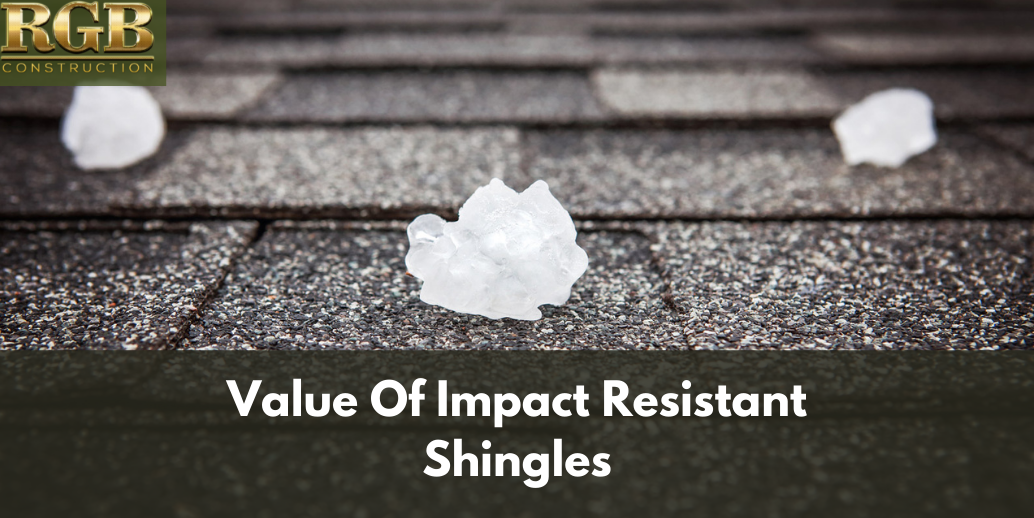Impact-resistant shingles have been around and used in roofing homes since the 1990s and their value to homeowners has only seen an increase in years since. What is it about these types of shingles that bring value to a home? Is one reason because of how they are put together which makes them resistant to certain weather, like hail and heavy storms? You would think so. What is the fervor over this kind of shingle?
Impact Resistant Shingle Rating
The roofing industry rates impact-resistant shingles with a UL 2218 Class 4 rating. The rating test means that a 2-inch steel ball is dropped onto a shingle several times in the same area and the impact on the shingle doesn’t show signs of rupture, glass mat breakage, or loss of granules.
Impact-resistant shingles are manufactured specifically with asphalt that’s rubberized and binds to a regular shingle. This process helps an impact-resistant shingle to sustain the force of hailstones. The rubbery shingle is flexible and rarely cracks under pressure.
A durability rating goes from Class 1 to Class 2, 3, and 4. The class rating depends on what the material can withstand in the way of cracks and ruptures. Class 4 materials are the best against any resistance.
Material Consistency
The actual creative process involves mixing the SBS with a regular shingle. They are bound to create a supple shingle that undergoes greater impact than any regular shingle, plus it won’t crack. Using the SBS formula delivers the advantages of an impact-resistant shingle and it helps with weathering.
Impact-resistant shingles are better than standard shingles because they have a base that is thicker. Manufacturers produce them with more flexibility than standard shingles. Styrene-butadiene-styrene or SBS is an asphalt formula with modifications that makes an impact-resistant shingle. You can also call an impact-resistant shingle rubberized asphalt.
With any roofing shingle, there are going to be different products that include impact-resistant materials and they all have variations between manufacturers. Companies offer impact-resistant shingles and installation of their products that are specifically made to coordinate with any style of home.
Knowing Whether a Shingle is Impact Resistant
You’ll recognize impact-resistant shingles by their many layers, plus they are much thicker than regular asphalt shingles. Any impact rating is shown on the underneath side of the shingle.
Cost of Impact Resistant Shingles
A major hail or windstorm can damage or destroy a roof at any time. A roof that contains impact-resistant shingles gets a favorable nod from insurance companies when a storm hits. Though impact-resistant shingles can be costly, you save money and gain value in the long run.
The expense of Class 4 impact resistant shingle installation that includes a 30-year life expectancy averages out to $2.500 and that depends on the size of the home. Though impact-resistant shingles can be costly at their time of installation, they require fewer repairs as time goes on, so you are saving money in the long run. Metal roofing is comparable and has resistance to hail damage, but metal roofing doesn’t fit in with the design of every house.
Worth of Impact Resistant Shingles
With the costs for impact-resistant shingles being high, you wonder if the cost is worth it and if the value is there? If you’re in an area where hailstorms are a normal activity, they are worth it and an excellent investment; however, if you live in an area where hailstorms rarely happen, you might consider other roofing options.
Misconceptions with Impact Resistant Shingles
There are some misconceptions about impact-resistant shingles that you should probably know for your own benefit.
An impact-resistant shingle may be resistant to hail and other severe weather, but they aren’t impact proof. Once a hail storm hits, shingles may face loss of granules and some denting where the hail has hit.
It may lessen the effects with the use of impact-resistant shingles, but the real benefit comes with the rubberized material, which makes your shingles less vulnerable to cracks or ruptures upon the direct hit of hail, tree limbs, or other debris.
When a shingle does crack, it’s not necessarily a product defect. This is an important misconception that homeowners have. Just because the UL 2218 test referred to earlier gives a positive picture of hail hitting your roof and your roof is not severely affected doesn’t mean that nature can’t throw a mean blow at your roof at another time and create cracks and ruptures. You may get hail that is larger and more persistent. Any major fluctuations can lead to shingle damage.
With hail damage, a warranty that is provided by a manufacturer won’t cover hail damage, even when you have impact-resistant shingles. When you’re looking at roofing for your home, companies may say that the manufacturer will cover roof damage and your insurance company won’t have to be bothered, don’t believe them. It may sound good but is not reflective of the big picture.
Maybe you’re thinking of impact-resistant shingles and aren’t sure if they’re the best value and the right fit for your budget or your home. If that’s the case, contact RGB Construction. Call them at call 856-264-9093. They’ll be able to answer questions you have about impact-resistant shingles and guide you towards what’s appropriate for your roofing situation.







